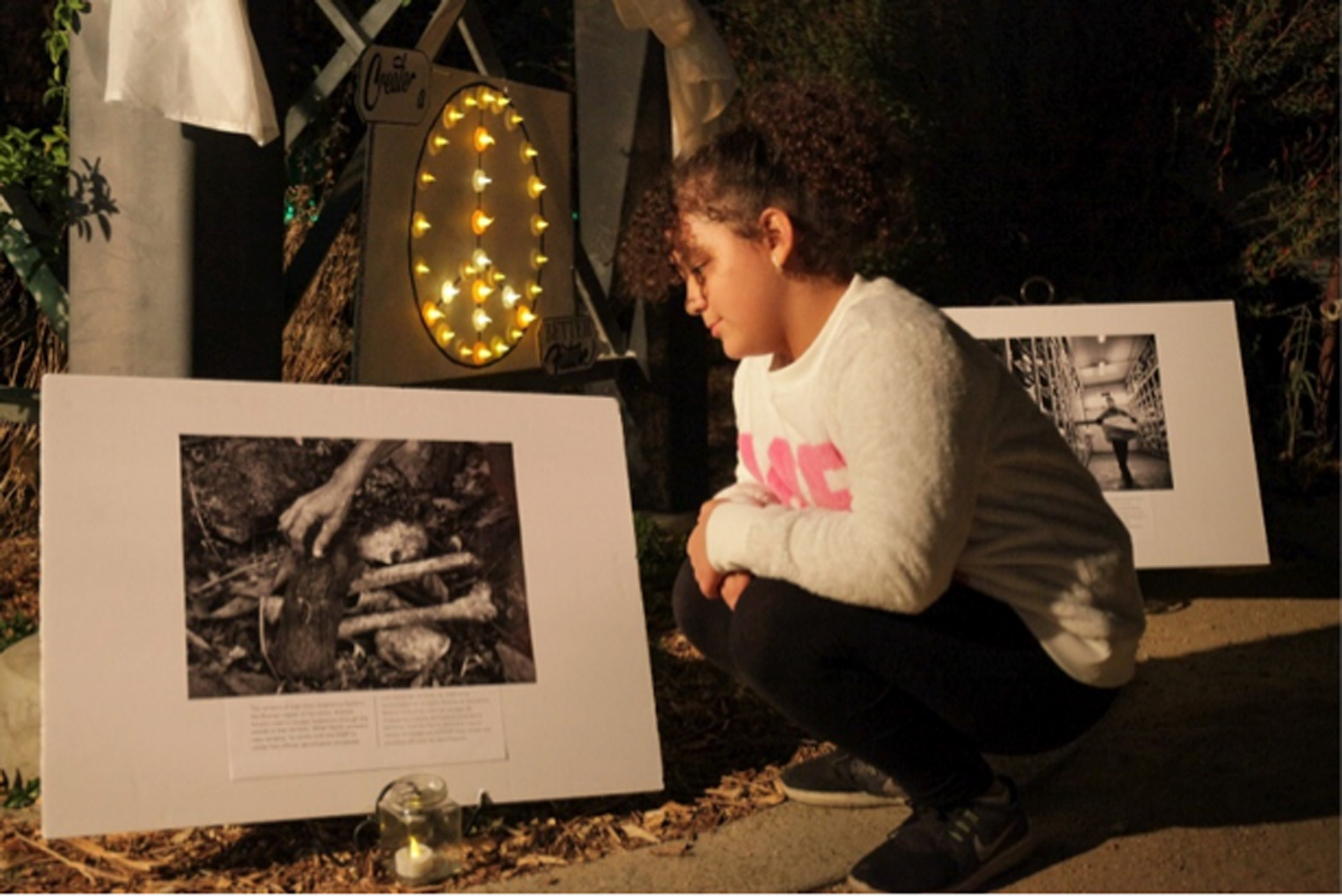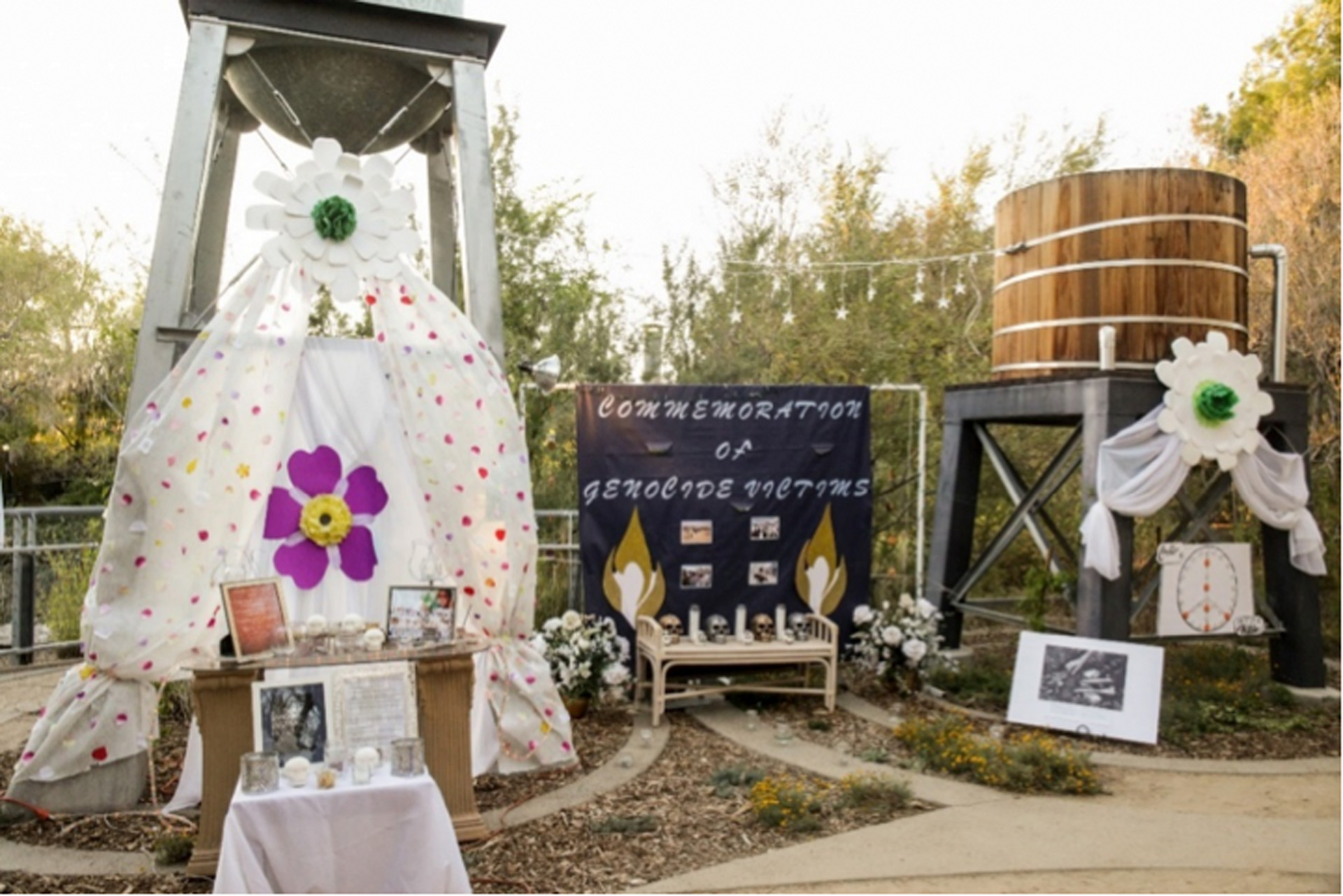
By Sindy Chaidez
Across cultures, the act of commemorating loved ones takes on many forms, from personal rituals to elaborate ceremonies. As part of the Mexican tradition of “Dia de los Muertos” (Day of the Dead), altars or shrines are adorned with flowers, candles, sugar skulls, smoky incense, and other items that pay tribute to the deceased. While this practice has traditionally been used to honor family members, loved ones, and public figures who have passed away, Dia de los Muertos also presents an opportunity, as a cultural platform, to bring attention to various social issues and/or injustices. As part of the 9th annual Dia de los Muertos event at Springs Preserve, Las Vegas, Nevada, I chose to dedicate my altar to the millions of genocide victims, both past and present, from around the globe. I was driven by the desire to educate people in my hometown about genocide and expose them to stories of the real human toll of this crime against humanity. The Dia de los Muertos event provided an opportunity to do this in a relatable, accessible way.
With this display, I wanted to not only educate people, but also to reach them on a personal level; to foster a deeper understanding that the wounds of genocide remain open, even after decades have passed. In consideration of the audience and type of event for which this material was to be presented, I knew the content should be visually engaging as well as educational. To this end, I collaborated with The Post-Conflict Research Center (PCRC) to curate my display. During my time as an intern for PCRC in the summer of 2017, I was able to see the innovative, multimedia-based work PCRC has produced to promote peace and prevent violent conflict in the Western Balkans and globally. One of the projects that struck me most was “Transitions”, a photo-based exhibition that explores the transitional justice processes of four countries: the Democratic Republic of the Congo, the US, Bosnia and Herzegovina, and Colombia. Each of the exhibition’s photos reaches the viewer at both an intellectual and emotional level. I decided to adapt Transitions to this event, choosing a selection of photos I felt my audience would find most compelling. The photos were accompanied by captions (in both Spanish and English) that further contextualized Bosnia and Herzegovina’s post-conflict challenges and transitional justice processes. Visitors were visibly moved by the photographs, particularly by the images of the Mothers of Srebrenica, many of whom have loved ones who are still missing or have yet to be identified. One visitor, Emita Peña, walked away with tears in her eyes stating, “I cannot imagine the pain those mothers and their families have endured.”


To visually engage visitors further, I recreated large and small-scale commemorative symbols for the display. I hung the Srebrenica white and green flower that commemorates the 8,372 Muslim men and boys that were killed on July 11, 1995 in Srebrenica, Bosnia and Herzegovina. Alongside the Srebrenica flower was the purple Forget-Me-Not in memory of the 100th anniversary of the Armenian Genocide where 1.5 million Armenians were killed. Flames, which symbolize the Kwibuka ceremony that is held to commemorate the nearly one million victims of the 100-day Rwandan genocide, were incorporated throughout the display. To incorporate the traditions of Dia de los Muertos, I emblazoned sugar skulls to present the names of the many countries and groups that are currently experiencing genocide: Syria, Darfur, the Yazidis in Iraq, and the Rohingya in Myanmar. I felt it was imperative to present past genocides alongside current to illustrate the fact that history can—and does—repeat itself and to drive home the importance of education and prevention in dismantling hate and discrimination to build sustainable peace.
While the nature of commemoration is undoubtedly solemn, the three-day event was imbued with a sense of hope. Visitors expressed positive feedback, asked for additional information and resources so that they could further educate themselves about genocide, and commented on the importance of bringing attention to these atrocities. After perusing the display, several visitors stopped to ask me to explain what constitutes genocide, when and where it has occurred, and how it can be prevented. One visitor asked how to pronounce ‘Srebrenica’ as she wanted to learn more about this particular genocide after viewing the photographs. Another visitor stated that the photographs had left her dumbfounded because she knew so little about the events that took place in Bosnia from 1992-1995. The educators in attendance expressed their interest in sharing the materials with their students and several parents knelt down to look into their children’s eyes when explaining to them what ‘genocide’ meant. One woman’s commented: “We will be able to make improvements once we remove the idea of “us” vs. “them,” and that comment, in particular, has stayed with me and was an indicator of the event’s success.
My involvement in this event further confirmed my belief that creative and innovative approaches are effective in drawing in audiences that might not be familiar with genocide and its lasting repercussions. Presenting content in a visually engaging manner is a powerful way to ignite discussion and spread the word about genocide and ongoing atrocities. It was my goal to connect local audiences to people in other parts of the world and to illustrate that, even if atrocities are occurring thousands of miles away, we all have the capacity for empathy based on our shared humanity. It was also my goal to remind people that the victims of conflict and genocide are more than just a statistic—they are mothers, fathers, daughters, sons, sisters and brothers who have hopes, dreams, and futures.

Among the flickering candles that illuminate the images of genocide’s aftermath, I placed a quote that has stayed with me since my visit to the Kigali Genocide Memorial Centre in Rwanda:
“Genocide is likely to occur again. Learning about it is the first step to understanding it.
Understanding it is imperative to respond to it. Responding to it is essential to save lives.
Otherwise ‘Never Again!’ will remain ‘Again and Again…!”
This quote perfectly depicts how important genocide education and awareness is for our future and presents the reasons why I have been so motivated to present this information to new audiences who, by and large, have never been exposed to firsthand accounts of genocide.

*Views expressed in this story reflect those of the author and not an organizational stance by PCRC.*


